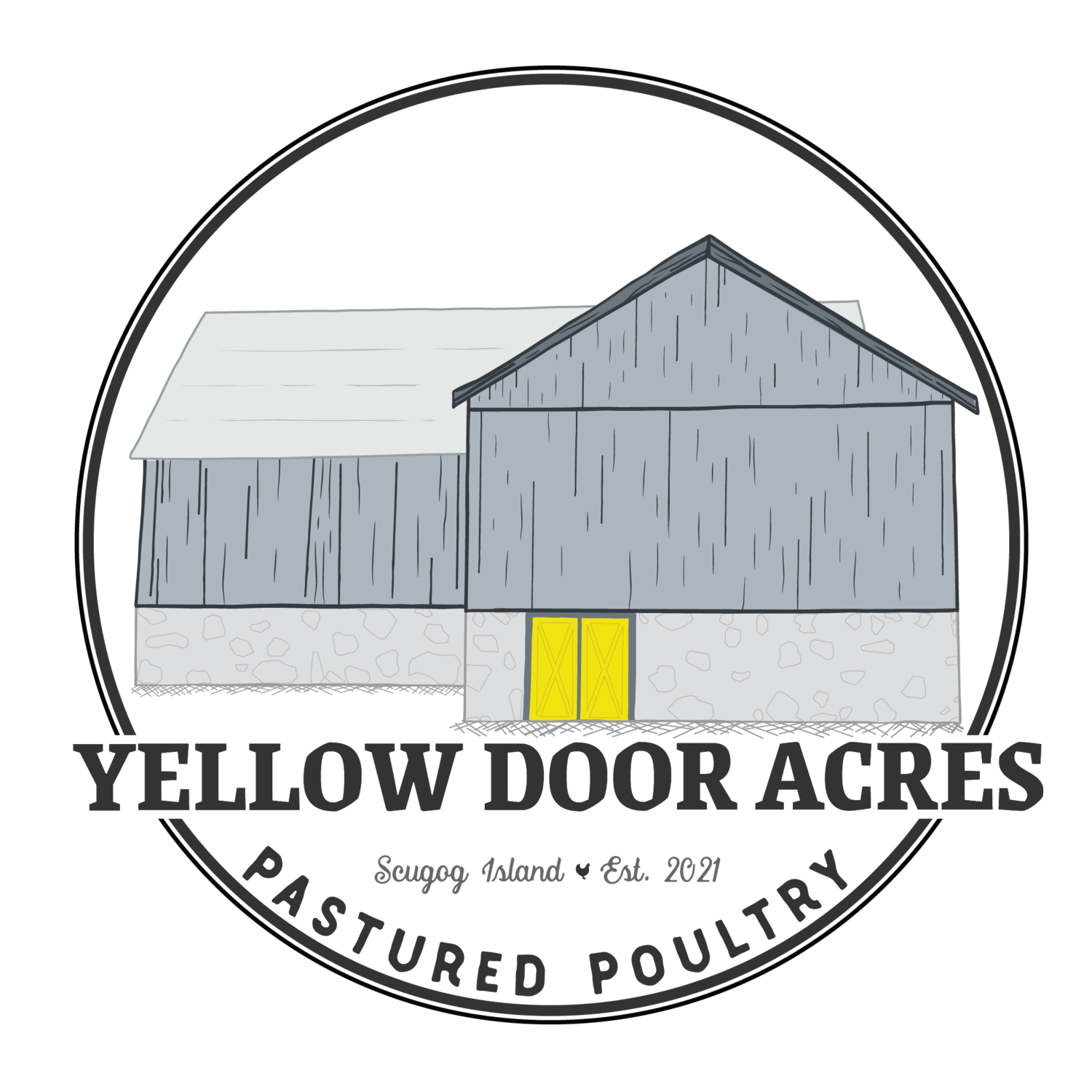Ready to be mother hen.
Chicken season is just around the corner, with less than two weeks before our first batch of chicks arrive. The last little while we’ve been busy getting ready to welcome our new fluffy friends and making sure they’ve got everything they need to grow before going out on pasture. In other words, we’ve been busy getting ready to be mother hen and setting up our brooders.
What is a brooder?
In nature, chicks huddle up underneath and around their mother hen when they’re first born for warmth and protection. Fulfilling the role of a mother hen, a brooder is an enclosure that provides chicks with warmth, shelter, food, water, and the comfort they need to grow stress free.
Our Brooder.
Last year at Yellow Door Acres, we built a large brooder inside of our barn with two heat lamps, two heat plates, a wire mesh lid, and several feeders and waterers to give our chicks all the essentials they need for a happy and healthy start.
Following last year’s success, we’ve built a second brooder of a similar style to accommodate even more chicks this year.
Getting the food and water right is pretty straightforward, just make sure you have enough feeders and waterers for the number of chicks in your flock and make sure it’s constantly clean. It’s everything else in the brooder that gets a bit trickier.
A few key things were top of mind when we came up with our brooder design:
Heat: Chicks cannot thermo-regulate for the first 4-6 days of their lives, meaning they cannot maintain the stable internal body temperature that’s needed to survive on their own. Simply put, their temperature is going to be the temperature of their surrounding. It’s critical not only to their survival but also to their overall health that the brooder maintains a constant warm temperature. That’s why we use heat lamps and heat plates, providing multiple heat sources and ways for our chicks to stay warm. We find the chicks also like the shelter of the heat plate, often huddling underneath it the same way they would their mother hen. Having multiple heat sources also creates a redundancy for us—if one source of heat goes out, there’s still another source for the chicks to rely on.
Space: You wouldn’t want to be crammed into a new space with a bunch of people and neither do chicks. We’ve built our brooders slightly bigger than needed to accommodate the number of chicks in each flock, to ensure every chick has more space than needed to be comfortable. But, there is such a thing as too much space. If a brooder is too big, an adventurous chick may wander too far from the flock and suffer or die. To prevent that from happening we have a dividing board that lets us control how much space is available inside the brooder and adjust as needed. There should be enough space to encourage chicks to get their daily steps in, but not enough for them to stray away from the flock.
Lighting: You can’t beat natural light. Our brooders face the side of our barn and two windows to let those UV rays shine down on our chicks during the day time. The side of the brooder facing the windows is also slightly shorter than the other, creating a slant in the top of the brooder to let more light in. Directly above the brooder we have our heat lamps and other light fixtures so we can adjust the lighting to meet the flock’s needs throughout the day. The natural light in our brooder helps get our chicks into a healthy sleep-wake cycle and prepares them for the pasture. By constantly monitoring and controlling the amount of light in the brooder, we also make sure they have enough to move around easily, eat, and drink.
Air Flow: The large wire mesh lid and windows also help us provide proper air ventilation for our chicks. There is a whole host of problems that can creep into your flock if you don’t have good air quality that can damage their respiratory system. The size and access to fresh air in our brooders helps get air circulating so our chicks can breathe easy. If you’ve ever been in or near a brooder, you also know how much it can smell. Chick litter stinks and is unpleasant, but worse it produces ammonia that can damage a chick’s lungs. Dust and ammonia should always be at a minimum.
Cleaning: Chickens poop, a lot. Having a shorter wall on the one side of the brooder also gives us easy access to check the bedding is clean and dry at all times and perform daily cleanings. Each wall of our brooders are also fully detachable. Being able to remove each wall separately makes it easier and more efficient for us to clean out the brooders between each flock. It also allows us to take down and move the brooders in the offseason so we can use that space for another purpose on the farm.
Protection: From time to time a barn can attract some unwanted guests. In case that happens, we’ve also built our brooders to provide protection from any predators. The brooders sit on concrete slabs, feature wooden walls, and quarter-inch wire mesh on top so our chicks are safely enclosed from all sides.
Happy chicks = Healthy chicks
Finishing touches.
The brooders are built, but we’re still not quite ready yet. With the recent cooler temperatures, we’re adding insulation to the walls of the brooders to help keep all the heat in and any drafts out. The barn and brooders are also getting a thorough cleaning before the chicks arrive, to clear out all of the dust, disinfect everything, and get set-up to maintain biosecurity.
It’s the home stretch and we can already hear the chicks chirping. For a sneak peak, check out the short video below from our brooder last year.


